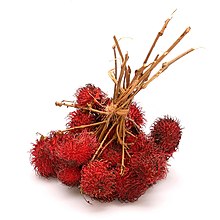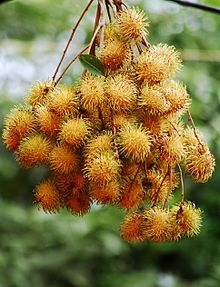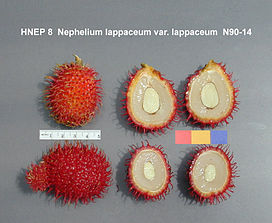Rambutan
| Rambutan | |
|---|---|

| |
| Unpeeled and peeled rambutan fruit | |

| |
| Rambutan fruits | |
| Scientific classification | |
| Kingdom: | Plantae |
| Clade: | Tracheophytes |
| Clade: | Angiosperms |
| Clade: | Eudicots |
| Clade: | Rosids |
| Order: | Sapindales |
| Family: | Sapindaceae |
| Genus: | Nephelium |
| Species: | N. lappaceum
|
| Binomial name | |
| Nephelium lappaceum | |
| Synonyms[3] | |
|
List
| |
Rambutan(/ræmˈbuːtən/ram-BOO-tən;Nephelium lappaceum) is a medium-sized tropical tree in the familySapindaceae.[3]The name also refers to the edible fruit produced by this tree. The rambutan is native to Southeast Asia.[1]It is closely related to several other edibletropical fruits,including thelychee,longan,pulasan,andquenepa.[4][5]
Description
[edit]It is anevergreentree growing to a height of 15–24 metres (49–79 ft).[5][6]The leaves are alternate, 14–30 cm long,pinnate,with three to 11 leaflets, each leaflet 5–15 cm wide and 3–10 cm broad with an entire margin.[citation needed]
The flowers are small, 2.5–5 mm,apetalous,discoidal,and borne in erect terminalpanicles15–30 cm wide.[5]Rambutan trees can be male (producing onlystaminateflowers and, hence, produce no fruit), female (producing flowers that are only functionally female), orhermaphroditic(producing flowers that are female with a small percentage of male flowers).[citation needed]
Fruit
[edit]The fruit is a round to oval single-seededdrupe,3–6 cm (rarely to 8 cm) long and 3–4 cm broad, borne in a loose pendant cluster of 10–20 together. The leathery skin is reddish (rarely orange or yellow) and covered with fleshy pliable spines, hence the name, which means 'hairs'. The spines (also known as "spinterns" ) contribute to thetranspirationof the fruit, which can affect the fruit's quality.[7]
The fruit flesh, thearil,is translucent, whitish, or very pale pink, with a sweet, mildly acidic flavor reminiscent ofgrapes.[5]
The single seed is glossy brown, 1–1.3 cm, with a whitebasalscar.[5]Soft and containing equal portions ofsaturatedandunsaturated fats,the seed may be cooked and eaten, but is bitter and hasnarcoticproperties.[8]: 14 [9]
History
[edit]Around the 13th to 15th centuries, Arab traders, who played a major role inIndian Ocean trade,introduced rambutans toZanzibarandPembainEast Africa.[4]There are limited rambutan plantings in some parts of India. In the 19th century, the Dutch introduced rambutans fromIndonesiain Southeast Asia, toSurinamein South America. Subsequently, the plants spread to the tropical Americas, planted in the coastal lowlands of Colombia, Ecuador, Honduras, Costa Rica, Trinidad, and Cuba. In 1912, rambutans were introduced to the Philippines from Indonesia.[4]Further introductions were made in 1920 (from Indonesia) and 1930 (from Malaya), but until the 1950s its distribution was limited.[citation needed]
There was an attempt to introduce rambutans to theSoutheastern United States,with seeds imported fromJava,Indonesia in 1906, but the species proved to be unsuccessful,[4]except inPuerto Rico.[5]
Etymology
[edit]The namerambutanis derived from theMalaywordrambutmeaning 'hair' referring to the numerous hairy protuberances of the fruits, together with the noun-buildingsuffix-an.[4][5]Similarly, inVietnam,they are calledchôm chôm(meaning 'messy hair').[10][better source needed]The Chinese name is hồng mao đan, literally 'red-haired pellet'.[11]
Composition
[edit] | |||||||||||||||||||||||||||||||||||||||||
| Nutritional value per 100 g (3.5 oz) | |||||||||||||||||||||||||||||||||||||||||
|---|---|---|---|---|---|---|---|---|---|---|---|---|---|---|---|---|---|---|---|---|---|---|---|---|---|---|---|---|---|---|---|---|---|---|---|---|---|---|---|---|---|
| Energy | 343 kJ (82 kcal) | ||||||||||||||||||||||||||||||||||||||||
20.87 g | |||||||||||||||||||||||||||||||||||||||||
| Dietary fiber | 0.9 g | ||||||||||||||||||||||||||||||||||||||||
0.21 g | |||||||||||||||||||||||||||||||||||||||||
0.65 g | |||||||||||||||||||||||||||||||||||||||||
| |||||||||||||||||||||||||||||||||||||||||
| Other constituents | Quantity | ||||||||||||||||||||||||||||||||||||||||
| Water | 78.3 g | ||||||||||||||||||||||||||||||||||||||||
| †Percentages estimated usingUS recommendationsfor adults,[12]except for potassium, which is estimated based on expert recommendation fromthe National Academies.[13] | |||||||||||||||||||||||||||||||||||||||||

Nutrients
[edit]Rambutan fruit is 78% water, 21%carbohydrates,1%protein,and has negligiblefat(table; data are for canned fruit in syrup; raw fruit data are unpublished). In terms of nutritional content, the canned fruit contains onlymanganeseat a moderate level (16% of theDaily Value), while providing 82caloriesin a 100 gram reference amount (table). Othermicronutrientsare at a low level.[citation needed]
Phytochemicals
[edit]As an un-pigmented fruitflesh,rambutan does not contain significantpolyphenolcontent,[14]but its colorfulrinddisplays diversephenolic acids,such assyringic,coumaric,gallic,caffeic,andellagic acids.[15][16]Rambutan seeds contain equal proportions ofsaturatedandunsaturatedfatty acids,wherearachidic(34%) andoleic(42%) acids, respectively, are the highest in fat content.[9]
The pleasantfragranceof rambutan fruit derives from numerousvolatile organic compounds,includingbeta-damascenone,vanillin,phenylacetic acid,andcinnamic acid.[17]
Ecology
[edit]Pollination
[edit]Aromatic rambutan flowers are highly attractive to many insects, especially bees. Flies (Diptera), bees (Hymenoptera), and ants (Solenopsis) are the main pollinators. Among the Diptera,Luciliaspp. are abundant, and among the Hymenoptera,honey bees(Apis dorsataandA. cerana) and thestingless beegenusTrigonaare the major visitors.[5]A. ceranacolonies foraging on rambutan flowers produce large quantities ofhoney.Bees foraging for nectar routinely contact thestigmaof female flowers and gather significant quantities of the sticky pollen from male blossoms. Little pollen has been seen on bees foraging female flowers. Although male flowers open at 06:00, foraging byA. ceranais most intense between 07:00 and 11:00, tapering off rather abruptly thereafter. In Thailand,A. ceranais the preferred species for small-scale pollination of rambutan. Its hair is also helpful in pollination where pollen can be hooked on and transported to female flowers.[citation needed]
Varieties
[edit]Well over 200cultivarswere developed from selected clones available throughout tropical Asia.[4]Most of the cultivars are also selected for compact growth, reaching a height of only 3–5 m for easier harvesting.[citation needed]
Compared to propagated rambutan clones, rambutans taken from the wild have a higher acidity and potential for various food purposes.[18]In Indonesia, 22 rambutan cultivars were identified as good quality, with five as leading commercial cultivars: 'Binjai', 'Lebak Bulus', 'Rapiah', 'Cimacan' and 'Sinyonya', with other popular cultivars including 'Simacan', 'Silengkeng', 'Sikonto' and 'Aceh kuning'.[4]In theMalay Peninsula,commercial varieties include 'Chooi Ang', 'Peng Thing Bee', 'Ya Tow', 'Azimat', and 'Ayer Mas'.[4]
In Nicaragua, a joint World Relief–European Union team distributed seedlings to organizations such as Ascociación Pueblos en Acción Comunitaria in 2001 to more than 100 farmers.[citation needed]Some of these farmers saw the first production of rambutans from their trees in 2005–2006 with development directed at the local market.
In the Philippines, two cultivars of rambutans are distinguished by their seed.[citation needed]The common rambutan seed and fruit are difficult to separate, while the 'Maharlika Rambutan' fruit separates cleanly from its seed. The fruit taste and size of these two cultivars are identical, but the 'Maharlika Rambutan' is more popular with a higher price.
Uses
[edit]Culinary
[edit]The fruit of the rambutan tree may be eaten raw by removing the peel, eating the pulp, and discarding the seed. Rambutan is most often used in desserts, such as sorbets and puddings, but also incurriesand savory dishes. The flavor is similar to lychee and pairs well with other tropical fruits.[citation needed]
Cultivation
[edit]Rambutans are adapted to warm tropical climates, around 22–30 °C, and are sensitive to temperatures below 10 °C.[5]It is grown commercially within 12–15° of the equator.[19]The trees grow well at elevations up to 500 m (1,600 ft) above sea level and do best in deep soil, clay loam, or sandy loam rich in organic matter. They grow on hilly terrain where there is good drainage.[19]
Rambutans are propagated bygrafting,[19]air-layering,[19]andbudding.Budded trees may fruit after two to three years with optimum production occurring after eight to 10 years. Trees grown from seed bear after five to six years.
The aril is attached to the seed in some commercial cultivars, but "freestone"cultivarsare available and in high demand. Usually, a single light brown seed is found, which is high in certain fats and oils (primarilyoleic acidandarachidic acid)[9]valuable to industry, and used in cooking and the manufacture ofsoap.Rambutan roots, bark, and leaves have various uses intraditional medicine[4]and in the production of dyes.

In some areas, rambutan trees can bear fruit twice annually, once in late fall and early winter, with a shorter season in late spring and early summer.[4]Other areas, such as Costa Rica, have a single fruit season, with the start of the rainy season in April stimulating flowering, and the fruit is usually ripe in August and September. The fragile fruit must ripen on the tree, then they are harvested over a four- to seven-week period. The fresh fruit are easily bruised and have a limited shelf life. An average tree may produce 5,000–6,000 or more fruit (60–70 kg or 130–155 lb per tree).[4]Yields begin at 1.2 tonnes per hectare (0.5 tons/acre) in young orchards and may reach 20 tonnes per hectare (8 tons per acre) on mature trees. InHawaii,24 of 38 cultivated hectares (60 of 95 acres) were harvested producing 120 tonnes of fruit in 1997. Yields could be increased by improved orchard management, including pollination, and by planting high-yielding compact cultivars.[4]
Most commercial cultivars are hermaphroditic; cultivars that produce only functionally female flowers require the presence of male trees.[4]Male trees are seldom found, as vegetative selection has favored hermaphroditic clones that produce a high proportion of functionally female flowers and a much lower number of flowers that producepollen.Over 3,000 greenish-white flowers occur in male panicles, each with five to seven anthers and a nonfunctional ovary. Male flowers have yellow nectaries and five to seven stamens. About 500 greenish-yellow flowers occur in each hermaphroditic panicle. Each flower has six anthers, usually a bilobed stigma, and one ovule in each of its two sections (locules).[5]The flowers are receptive for about one day but may persist if pollinators are excluded.[citation needed]
In Thailand, rambutan trees were first planted inSurat Thaniin 1926 by the Chinese Malay K. Vong inBan Na San.An annual rambutan fair is held during August harvest time.[20]
In Malaysia, rambutan flowers from March to July and again between June and November, usually in response to rain following a dry period. Flowering periods differ for other localities. Most, but not all, flowers open early in the day. Up to 100 flowers in each female panicle may be open each day during peak bloom. The initial fruit set may approach 25 percent, but a high abortion level contributes to a much lower level of production at harvest (1 to 3 percent). The fruit matures 15–18 weeks after flowering.[citation needed]
Rambutan cultivation in Sri Lanka mainly consists of small home gardens.Malwana,a village in theKelani RiverValley, is popular for its rambutan orchards. Their production comes to market in May, June, and July when it is very common to observe seasonal traders along the streets ofColombo.Sri Lanka also has some off-season rambutan production in January and February in areas such asBibile,Medagama,andMonaragala.[citation needed]
Both male and female flowers are faintly sweet-scented and have functional nectaries at the ovary base. Female flowers produce two to three times morenectarthan male flowers. Nectar sugar concentration ranges between 18–47 percent and is similar between the flower types. Rambutans are an importantnectar sourcefor bees in Malaysia.[citation needed]
Cross-pollination is a necessity because the anther is absent in most functionally female flowers. Althoughapomixismay occur in some cultivars, rambutans, like lychee, are dependent upon insects for pollination. In Malaysia, where only about one percent of the female flowers set fruit, no fruit is set on bagged flowers while hand pollination resulted in a 13 percent fruit set. Pollinators may maintain fidelity to either male or hermaphroditic flowers (trees), thus limiting pollination and fruit set under natural conditions where crossing between male and female flowers is required.
Production
[edit]
Rambutan is a fruit tree cultivated in humid tropical Southeast Asia.[4][21]It is a common garden fruit tree and propagated commercially in smallorchards.It is one of the best-known fruits of Southeast Asia and is also widely cultivated elsewhere in the tropics including Africa, southern Mexico, the Caribbean islands, Costa Rica, Honduras, Guatemala, Panama, India, Vietnam, Philippines, and Sri Lanka.[4]It is also produced in Ecuador where it is known asachotillo,and on the island ofPuerto Rico.[5]
As of 2014[update],Thailand was the largest producer of rambutans (Thai:เงาะ,RTGS:ngo),[21]growing 450,000tonnes,followed by Indonesia at 100,000 tonnes, and Malaysia, 60,000 tonnes.[21]In Thailand, the major cultivation centers areChanthaburi Province,followed byChumphon ProvinceandSurat Thani Province.[21]In Indonesia, the production center of rambutan is in the western parts of Indonesia, which includesJava,Sumatra,andKalimantan.[22]In Java, the orchards andpekarangan(habitation yards) in the villages ofGreater JakartaandWest Javahave been known as rambutan production centers sincethe colonial era,with a trading center inPasar Minggu,South Jakarta.[citation needed]
During 2017 and years before, imports of rambutan to theEuropean Unionwere about 1,000tonnesannually, enabling a year-round supply from numerous tropical suppliers.[23]
The fruits are usually sold fresh and have a short shelf-life,[21]and are commonly used in making jams and jellies, or canned. Evergreen rambutan trees with their abundant colored fruit make attractive landscape specimens.[5]
In India, rambutan is imported from Thailand,[24]as well as grown inthe Pathanamthitta Districtof the southern state ofKerala.[25]
Rambutans are notclimactericfruit—that is, they ripen only on the tree and appear not to produce a ripening agent, such as theplant hormoneethylene,after being harvested.[5]However, at post-harvest, the quality of the fruit is affected by storage factors. Low humidity levels, storage time, and incidences of mechanical damage can severely affect the quality of the fruit which would negatively affect the demand for such.[26]In general, the fruit has a short shelf life in ambient conditions but implementing methods that can extend such is a productional advantage. Certain treatments like irradiation and the use of hot-forced air can help in fruit preservation although the former has seen more success.[27]
Distribution
[edit]The center of genetic diversity for rambutans is theIndonesianregion.[4]They have been widely cultivated insoutheast Asiaareas, such asMalaysia,Thailand,Myanmar,Sri Lanka,Indonesia,Singapore,andthe Philippines.[28][8]It has spread from there to parts of Asia, Africa, Oceania, and Central America.[29]
Gallery
[edit]-
Young rambutan fruit in Malaysia
-
Ripe yellow rambutan fruit in Malaysia
-
Unripe rambutan fruits in the Philippines
-
'Rambutan Binjai', one of the leading cultivars in Indonesia
-
Three colors of rambutan
See also
[edit]References
[edit]- ^abBarstow, M. (2017)."Nephelium lappaceum".IUCN Red List of Threatened Species.2017:e.T33266A67808476.doi:10.2305/IUCN.UK.2017-3.RLTS.T33266A67808476.en.Retrieved19 November2021.
- ^"Nephelium lappaceum".Integrated Taxonomic Information System.Retrieved18 September2010.
- ^ab"Nephelium lappaceumL. "World Flora Online.World Flora Consortium. 2023.Retrieved30 June2023.
- ^abcdefghijklmnopMorton, J. F. (1987).Fruits of Warm Climates.West Lafayette, Indiana, USA: Center for New Crops & Plant Products, Purdue University Department of Horticulture and Landscape Architecture. pp. 262–265.
- ^abcdefghijklm"The Rambutan Information Website".Panoramic Fruit Farm, Puerto Rico.Retrieved25 June2011.
- ^Grant, Amy (19 April 2021)."Rambutan Growing Tips: Learn About Rambutan Tree Care".Gardening Know How.Retrieved22 July2022.
- ^Arévalo-Galarza, M.L.; Caballero-Pérez, J.F.; Valdovinos-Ponce, G.; Cadena-Iñiguez, J.; Avendaño-Arrazate, C.H. (March 2018). "Growth and histological development of the fruit pericarp in rambutan (Nephelium lappaceum Linn.)".Acta Horticulturae(1194): 165–172.doi:10.17660/actahortic.2018.1194.25.ISSN0567-7572.
- ^abTindall, H. D. (1 January 1994).Rambutan Cultivation.Food and Agriculture Organization.ISBN978-92-5-103325-8.
- ^abcManaf YN, Marikkar JM, Long K, Ghazali HM (2013)."Physico-chemical characterisation of the fat from red-skin rambutan (Nephellium lappaceum L.) seed".J Oleo Sci.62(6): 335–43.doi:10.5650/jos.62.335.PMID23728324.
- ^"Vietnamese tropical fruit".8 May 2012.Retrieved7 October2012.
- ^Siong Kiat Tan; Keng Soon Chua; Kok Peng Lim (2019).MINNAN (HOKKIEN) BOTANICAL NAMES USED IN SINGAPORE(PDF).University of Singapore.
- ^United States Food and Drug Administration(2024)."Daily Value on the Nutrition and Supplement Facts Labels".FDA.Archivedfrom the original on 2024-03-27.Retrieved2024-03-28.
- ^National Academies of Sciences, Engineering, and Medicine; Health and Medicine Division; Food and Nutrition Board; Committee to Review the Dietary Reference Intakes for Sodium and Potassium (2019). Oria, Maria; Harrison, Meghan; Stallings, Virginia A. (eds.).Dietary Reference Intakes for Sodium and Potassium.The National Academies Collection: Reports funded by National Institutes of Health. Washington, DC: National Academies Press (US).ISBN978-0-309-48834-1.PMID30844154.Archivedfrom the original on 2024-05-09.Retrieved2024-06-21.
- ^Gorinstein S, Zemser M, Haruenkit R, Chuthakorn R, Grauer F, Martin-Belloso O, Trakhtenberg S (1999). "Comparative content of total polyphenols and dietary fiber in tropical fruits and persimmon".J Nutr Biochem.10(6): 367–71.doi:10.1016/s0955-2863(99)00017-0.PMID15539312.
- ^Thitilertdecha N, Teerawutgulrag A, Kilburn JD, Rakariyatham N (2010)."Identification of major phenolic compounds from Nephelium lappaceum L. and their antioxidant activities".Molecules.15(3): 1453–65.doi:10.3390/molecules15031453.PMC6257335.PMID20335993.
- ^Sun L, Zhang H, Zhuang Y (2012). "Preparation of free, soluble conjugate, and insoluble-bound phenolic compounds from peels of rambutans (Nephelium lappaceum) and evaluation of antioxidant activities in vitro ".J Food Sci.77(2): C198–204.doi:10.1111/j.1750-3841.2011.02548.x.PMID22250923.
- ^Ong PK, Acree TE, Lavin EH (1998). "Characterization of Volatiles in Rambutan Fruit (Nephelium lappaceum L.)".J Agric Food Chem.46(2): 611–615.doi:10.1021/jf970665t.PMID10554286.
- ^Kong, Fei Chai; Mohd Adzahan, Noranizan; Karim, Roselina; Rukayadi, Yaya; Mohd Ghazali, Hasanah (2018-07-31)."Selected Physicochemical Properties of Registered Clones and Wild Types Rambutan (Nephelium lappaceumL.) Fruits and Their Potentials in Food Products ".Sains Malaysiana.47(7): 1483–1490.doi:10.17576/jsm-2018-4707-16.ISSN0126-6039.
- ^abcd"Third Regional Workshop on Tropical Fruits".Iica's Contribution to the Agricultural Sector in Trinidad and Tobago During.Instituto Interamericano de Cooperación para la Agricultura: 86. 1994.ISSN0253-4746.
- ^Agar, Charles; Eveland, Jennifer (2005).Frommer's Southeast Asia.John Wiley & Sons.p. 158.ISBN978-0-7645-7829-8.Retrieved18 September2010.
- ^abcdeLe Bellec, F. (June 2014)."Rambutan: The hairy cousin from the tropics".FruiTrop.No. 223.CIRAD.pp. 28–33.Retrieved11 July2019.
- ^R. Poerwanto."Rambutan and Longan Production in Indonesia".ISHS Acta Horticulturae 665: II International Symposium on Lychee, Longan, Rambutan and other Sapindaceae Plants.Retrieved11 July2015.
- ^"Exporting rambutan to Europe".Centre for the Promotion of Imports, Netherlands Ministry of Foreign Affairs. 14 February 2019.Retrieved24 February2021.
- ^Shantanu Nandan Sharma (2006-05-07)."Thailand wants to export Rambutan, longan to India".The Economic Times.Retrieved8 June2012.
- ^Kuttoor, Radhakrishnan (28 June 2009)."Farmers taking to Rambutan cultivation".The Hindu.Archived fromthe originalon 24 May 2012.Retrieved8 June2012.
- ^Landrigan, M.; Morris, S.C.; Gibb, K.S. (June 1996)."Relative Humidity Influences Postharvest Browning in Rambutan (Nephelium lappaceum L.)".HortScience.31(3): 417–418.doi:10.21273/hortsci.31.3.417.ISSN0018-5345.
- ^Follett, Peter A.; Sanxter, Suzanne S. (December 2000)."Comparison of Rambutan Quality after Hot Forced-air and Irradiation Quarantine Treatments".HortScience.35(7): 1315–1318.doi:10.21273/hortsci.35.7.1315.ISSN0018-5345.
- ^Windarsih, G.; Muhammad, E. (2019)."Morphological characteristics of flower and fruit in several rambutan (Nephelium lappaceum) cultivars in Serang City, Banten, Indonesia ".Biodiversitas Journal of Biological Diversity.20(5).doi:10.13057/biodiv/d200537.
- ^Paull, Robert E.; Duarte, Odilo (2012).Tropical Fruits.CABI.ISBN978-1-84593-789-8.







